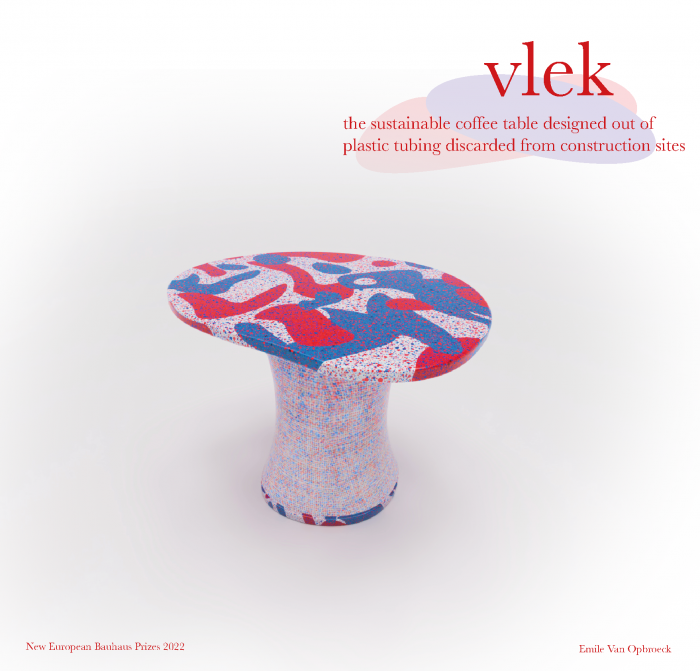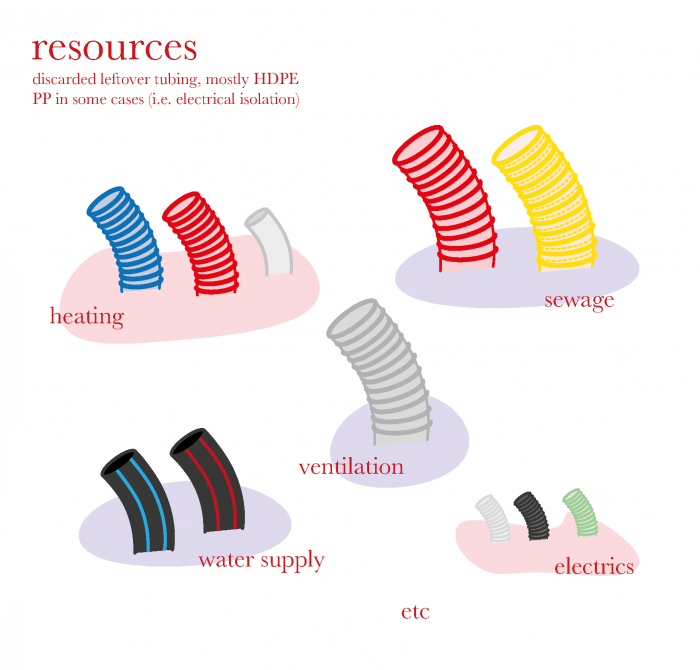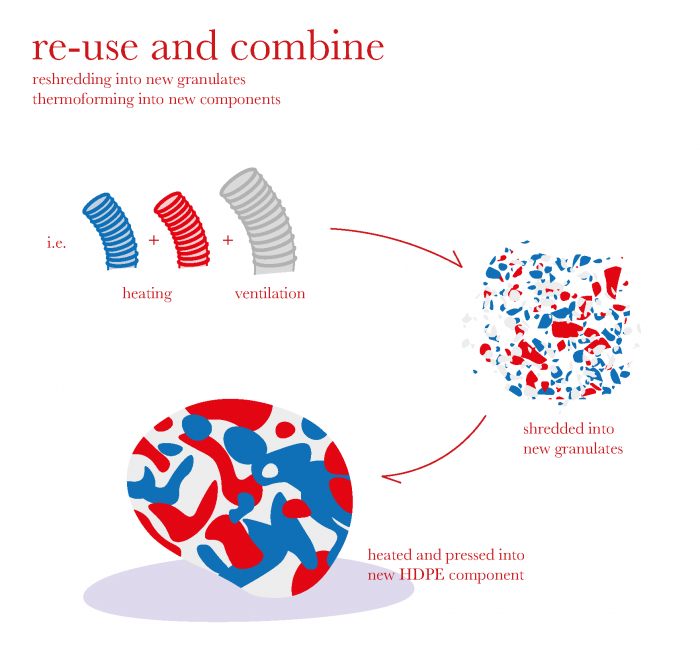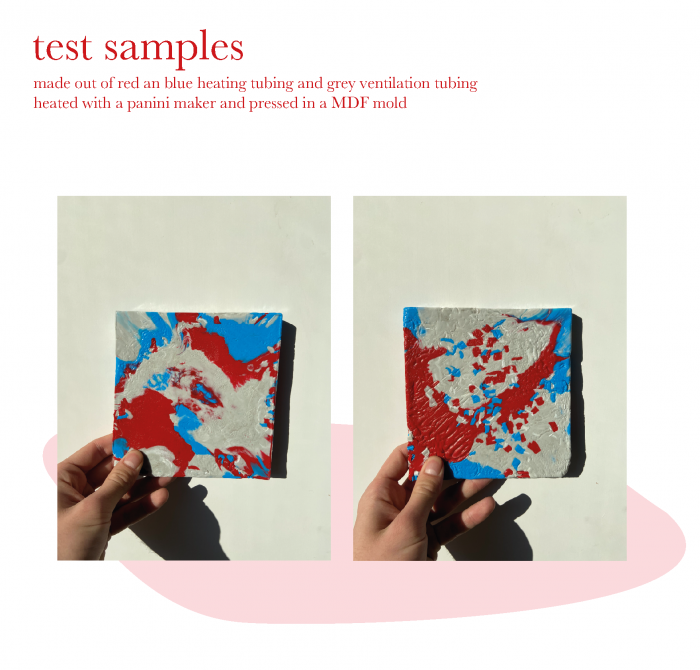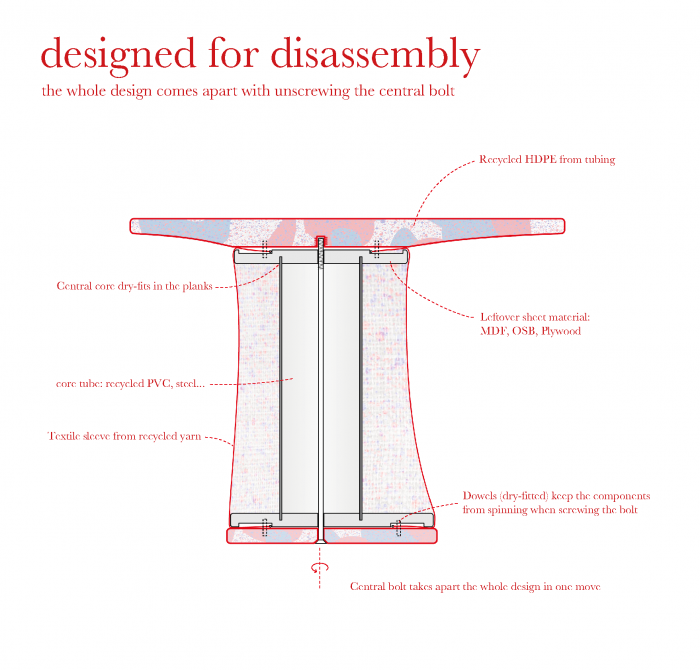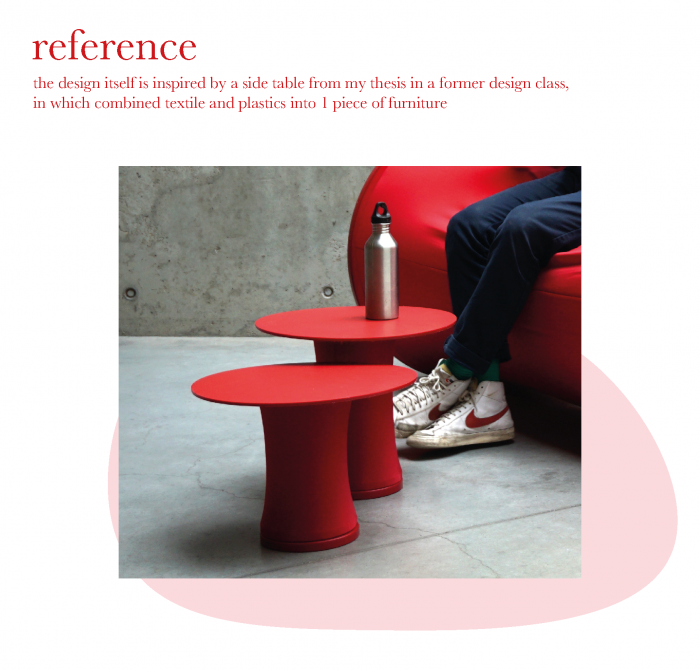VLEK is a sustainable coffee table designed out of the bright-colored leftovers from plastic tubing that are discarded from construction sites. It combines a playful and modern aesthetic with a straightforward technical design, while staying a local initiative. It could be described as either a piece of furniture, a circular statement and a boost for local creative communities and local circular economy.
By recently starting as a junior architect in a firm in Ghent, Belgium, I witnessed a waste stream which is not only often overlooked, but is responsible for the 2nd most amount of waste (in weight) produced by any other sector in Belgium: construction waste. In fact, the amount of waste even doubled from 11 million tonnes to 22 million tonnes of waste in 2018.
VLEK focuses on a particular, yet often used and discarded plastic of the construction industry: tubing. Plastic tubes and pipes are almost inseparably linked with construction, primarily used in construction of technical systems in modern architecture. Shredding and thermoforming into something new makes these tubes easy to recycle, and they have appealing, vibrant colours used for colour coding. For example in heating, hot means red and blue means cold. Yet combined they could make a playful colour scheme for design purposes.
The design itself focuses on composing a simple aesthetic through a minimum of technical intervention. Without using any glue, the design implies that any component can be easily separated and added to its specific waste stream once VLEK’s life cycle ends. It is designed for disassembly, yet durable and robust to last as long as possible. The whole design can easily be assembled or disassembled by unscrewing a single bolt, using a single hex/allen key. Requiring just a single operation with a simple tool makes VLEK approachable to the common household.
The result is a coffee table that has a table top and foot made out of recycled plastic tubing. Over the pedestal fits a textile sleeve stitched from recycled yarn, which houses the structure of the table. Together they make a playful, asymmetrical design that helps reducing one of the biggest waste streams of Europe, while being an affordable and aesthetically pleasing piece of furniture.
Please highlight how the concept/idea can be exemplary in this context
With Belgium’s rapidly growing housing needs and building culture, the growth in construction waste is not set to slow down anytime soon. In the whole of EU, the total figure grosses to a staggering 450 million tonnes. To make matters worse, three quarters of all this goes straight to landfill.
In construction, plastics are commonly used for technical purposes. Ventilation, heating, electricity… all use plastic tubing to connect technical installations. When thrown away, this adds up to a considerable amount of the total waste stream that is construction waste. Pieces of tubing that are too short for further usage, damaged electrical casings could easily be recycled. When it comes to plastics in general, 25 million tonnes is being discarded annually, a number which is set to be doubled by 2030. Again, only 30% of that number is being recycled.
VLEK provides a local framework for these plastics, and other construction waste in general. The core of the table is made out of any cutoffs of sheet material, and the textile surrounding the core structure is a piece of fabric made out of recycled textile.
Also, by unscrewing the central bolt, the whole design can be dismantled and recycled again after VLEK reaches the end of its own lifecycle, which makes the design cradle-to-cradle.
Please highlight how the concept/idea can be exemplary in this context
The aesthetics of VLEK are very straightforward, by combining vibrant VLEKs used in the technical departments. Combining these technical colours in a precise manner generates a pattern that consists of colours that were initially purely functional, but are now being percieved as an element of design and creativity. It even provides a transparent insight into recycled plastics, while provoking an awareness of the endless possibilities of circularity through a minimum of effort and resources.
Please highlight how the concept/idea can be exemplary in this context
This low-threshold approach to the design brings about a flatpack packaging, which streamlines transportation, delivery or retail in general. This approach incites the user to easily interchange any component - should it ever need repairing - instead of discarding the whole design.
By collaborating with local technicians, contractors and architects, VLEK offers an affordable design which uses local plastics leftovers through a minimum of effort. By keeping the production process rather artisanal than industrial, my role is to act as a local craftsman and designer, rather than a salesman of an industrially conceived product. This approach is similar to the business model of Wolvis (wolvis.be) , a local sustainable design brand I hold in high regard.
Creating a local network would also implies a very transparent approach to meeting the customer in the process: there is a full disclosure in how VLEK is made, transported, sold and even recycled again. The core concept of the product is very easy to be gripped and understood by a second life aware audience.
Also, by collaborating with local initiatives and population, the design itself evolves in continued cycles of improvement and redesign. VLEK is an endless improving product, fed by evaluation and feedback by peers.
Please highlight how this approach can be exemplary
VLEK combines a playful and modern aesthetic with a straightforward technical design, while staying a local initiative. It could be described as either a piece of furniture, a circular statement and a boost for local creative communities and local circular economy.
A construction site commonly is a highly fast-paced environment. Manual labor, stressed-out contractors, pressuring deadlines… create an atmosphere which encaptures and drives those involved to a shelter and a home, which is creating a building out of nothing. It requires a lot of resources, yet in the rush of the build no-one is concerned with by-products, excess or leftovers that are being discarded to develop said construction. Large containers at construction sites are filled with mixed garbage without sorting, or without considering what might happen with it in a further life. A lot of decisions and consequences with what happens next to waste are being made at the source, whether we separate our rubbish is an important step of the whole recycling process.
In Belgium, there are already a handful of local initiatives like OPALIS, Ecowerf, Buurman, ROTOR… which goal is to precisely collect and demolish used building components, and re-use them in new designs. While these initiatives focus on giving specific components a second life, I aim to re-use raw materials that are thrown away on site, such as polymers/plastics. In recent years I have gained an interest in polymers like HDPE, PP… and its usage, with it being easy to shred and thermoform into new objects.
There is already a wide variety of furniture made from plastic waste, like Dirk Van Der Kooij’s coffee tables. VLEK however focuses on a particular waste stream, thus relying on the same colours and tubes to make a consistent product. The textile pedestal also provides a softer appearance in contrast to the smooth, industrial plastic. Also, by being designed for disassembly all parts can easily be replaced or recycled again, while it can be transported as a flatpack.
Prototyping
- Testing out a full scale model
- Material and pattern research (both plastic and textile)
Collaborating/reaching out
After making a working prototype, I would want to observe, learn and study from existing companies and industry on how I could streamline the production process of VLEK:
- Material research: the SDG group (the Innologic branch in particular) are a nearby sustainability company, and they make it their goal to research and reverse engineer thermoplastics waste. Afterwards they research and develop techniques and methods to prototype new circular products out of re-used plastics.
- Waste stream processing: Collaborating with local waste processors such as Van Werven, who have high-end plastic waste processing plants. They could provide the first step in a manufacturing process through cleaning and shredding plastics.
- Waste collection: Local building waste companies such as Renewi, or even construction material companies such as Gedimat could help with both collecting discarded tubing and creating awareness on construction sites.
- Textile research: Local initiatives like Collectief Textiel specialize in weaving and sewing recycled yarn and fabric. While I have some experience in furniture and plastics, I could use some help with designing the fabric sleeve that goes around the pedestal.
Promotion
The final step of this circular loop is the promotion of VLEK into the retail market. I could use local companies, specialised in durable, sustainable and second life products to promote VLEK.
In addition, the communication package, offered in this contest, could help me tremendously in boosting VLEK. As a designer I have little knowledge about retail and marketing, therefore I would love to take advice from people who have.
If I would be awarded with VLEK, I would start by using the prize earnings to start a local workshop with a set of tools and hardware to work with re-used plastics. I have gained a very big interest in (circular) design over the recent years, and have always had the opportunity to use workspaces of friends and colleagues. But in time, I would love an own space where my experiments, creativity and crafts could be developed. The workspace could serve as a place where the local community could learn and get in touch with crafting.
More importantly, in this studio/workshop, circular projects such as VLEK could arise, which would be the first main objective as mentioned in the previous question.
@Van Opbroeck, 2022
Content licensed to the European Union.
